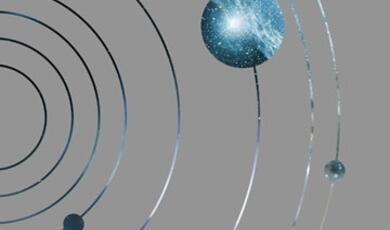Rotation in Space
Share
- Details
- Transcript
- Audio
- Downloads
- Extra Reading
Rotation is a fundamental physical process throughout the Universe. So much is spinning, from planets and stars revolving on their axes, to whole spiral galaxies rotating around their centre. We shall start by looking at the fundamentals of rotational motion, including the concept of angular momentum. This then will be extended to show what observations of rotation can tell us about how planetary systems form and develop, how neutron stars evolve with time, and how rotational motion provides crucial evidence for the presence and distribution of the elusive dark matter.
Download Transcript
1 February 2012
Rotation in Space
Professor Carolin Crawford
Introduction
Rotation is a property of a whole host of cosmic objects. We observe stars, planets, black holes and galaxies all to be spinning, some at phenomenal speeds. But why is rotation so ubiquitous? How can we tell that astronomical bodies are rotating? Why do some things spin and not others? And what can we learn from observations of this rotation?
I shall be considering two types of motion in this lecture, which are both commonly referred to as ‘rotation’:
Rotation is the action of an object moving around a centre, such as the Earth spinning around on its axis;
Revolution is the action of orbiting around an external point, such as the Moon revolving around the Earth.
The fundamental question to start with, however, is the simplest – Why does anything in the Universe rotate at all? The answer relies on the introduction of a very important concept, that of angular momentum.
Angular Momentum
Angular momentum, or rotational momentum, is an inherent property of rotating bodies which dictates the direction and rate they spin at. Difficult to explain, it is nonetheless something that we are all intuitively very familiar with. Like energy, or linear momentum, the angular momentum of a body or system is a conserved quantity; this means that the amount of angular momentum of an object is what it will always have in the future, and can only be changed by the application of an external twisting force to it (a torque).
Angular momentum is a vector quantity, meaning that a full description requires information of both an amount and a direction. One simplification is to say that for a body rotating around a particular axis (whether it be a bicycle wheel, a spinning top, or an entire planet), the physical quantity that is the product of
(mass) x (rotational rate) x (radius)2
is always conserved about that axis. This means that for a given mass with a certain angular momentum, if we change its radius, the object has to change its rotational speed in order that the amount of angular momentum is kept constant. An increase in radius slows the rotational rate, and a decrease quickens the spin. This is commonly illustrated by the way an ice skater will rotate faster when they draw their body in tighter to the spin axis. Another example is a somersaulting diver, who will compress their body to spin fast and achieve a number of somersaults before flattening out their body, slowing the spin before they splash down into the water.
[Videos used:]
Natalia Kanounnikova set the Guinness World Record for fastest spin on ice skates at Rockefeller Center, NYC
http://www.youtube.com/watch?v=AQLtcEAG9v0
Olympic diver Mark Lenzi performing 21/2 reverse somersault dive
http://www.youtube.com/watch?v=EAhNlWkWun0
How is this Relevant to Astronomy?
All astronomical objects are formed by the way that gravity pulls matter together; inherent in this process is a dramatic decrease in size. If a cosmic body originates from anything that had the tiniest amount of rotational motion originally, this spin rate will only become greatly enhanced as it collapses down. Things speed up as they collapse under gravity.
Consider a large cloud of molecular gas and dust about to collapse under gravity to form a star, or an enormous halo of hot gas that will contract to create a galaxy. If that cloud has the even the very slightest rotational motion right at the start – such as might be caused by a slight tug on one side due to the gravitational pull of a neighbouring cloud or star – the conservation of angular momentum means that the final star (or galaxy) that results from the collapse of this cloud will rotate in the same direction, only much, much faster. In fact, all stars are spinning, including our Sun.
The Sun’s Rotation
The Sun is not a solid body, but is made of gas. It rotates about an upright axis, only offset by about 7° from the vertical, but it has differential rotation, in that the rate of rotation changes with latitude. It rotates fastest at the equator, and this rate decreases with increasing latitude, until in the polar regions one rotation takes 10 days longer to complete than at the equator. How do we know this? Astronomers consider two rotation periods for an object under observation. The first is Sidereal Rotation, which is how long a body actually takes to rotate. The second, and perhaps more easily observed, is the Synodic Rotation,which measures how long it takes for a fixed feature on the surface of the body to rotate to the same apparent position as viewed from Earth. For the Sun, for example, the latter is slightly longer than the former, as during the time it has taken for the Sun to complete a sidereal rotation, some extra time is required to compensate for the orbital motion of the Earth around the Sun in the intervening period. We’ll return to this idea later.
Sunspots
The most obvious features used to track the rotation of the Sun are the sunspots on its disc. These are irregularly shaped dark regions that appear periodically at different latitudes on the Solar surface. Typical sunspots are some few tens of thousands of km across (comparable to the size of the Earth), and they last between a few hours and a few months. They appear darker than their surroundings as they are about 1500° cooler. Sunspots are associated with regions of intense magnetic fields (and are often the source of massive eruptions of plasma), so their number and location are useful tracers of the level of the Sun’s activity. Galileo was the first to study them in detail, and he determined that the Sun rotates once in about 4 weeks by tracking their progress across the Sun’s disc during the summer of 1612.
Today we also use helioseismology – the way that sound waves travel through the interior of the Sun and cause it to oscillate (see my last lecture on The Sounds of the Universe) – to show that the interior of the Sun doesn’t spin in exactly the same way as its surface. The very inner regions, such as the core and its immediately surrounding radiative zone rotate more like a solid body than the outer layers that carry the sunspots.
Stellar Rotation
Other stars are also magnetically active, with similar dark ‘starspots’ on their surface, which can be used to determine their rotation rate. Unlike the Sun, individual spots cannot be resolved, but their presence is inferred by the way they will temporarily dim the brightness of the star by a microscopic amount as they move across the stellar disc. This signal can, however, be confused by both the presence of any transiting planets, or inherent variability in the star’s output.
A better method comes from the analysis of the width of dark absorption features in a star’s spectrum, which are smeared out to appear broader than expected if the star’s rotation is favourably oriented with respect to our line of sight. This is because the spectrum includes a contribution from both light that is blueshifted from the limb of the star travelling towards us, and that is redshifted from the other limb moving away. The amount of these shifts are related to the velocity at which the limbs of the star are moving, and hence the star’s rotation rate.
Planetary Systems
A star is unlikely to form in isolation, as not all the matter in the rotating, collapsing cloud will be incorporated into the brand new star at the centre. Some of the cloud material will not yet have been accreted onto the core before sufficiently high temperatures are reached and nuclear fusion is ignited, marking the birth of a proto-star. The remaining material instead settles into a concentrated, opaque dusty disc of matter known as a proplyd (short for ‘proto-planetary disc’), which can extend to a radius some 50 times (or more) the distance between the Sun and Pluto.
But why does the material settle into the shape of a disc? Things flatten out as they collapse down. A cloud of particles will naturally flatten down if there is any net sense of rotation to the system. As the cloud contracts it becomes denser, thus increasing the number of collisions between particles that act to average all the random motions of particles within the cloud, leaving only the systemic rotational motion.
Imagine a large cloud of moving particles, where each follows an orbit randomly tilted with respect to the others, although there is a slight overall bias for the majority to be going either clockwise or anti-clockwise. As the cloud increases in density, each particle will undergo a succession of collisions with the others. Each of these collisions will result in the two impactors sharing their average velocity after the event. Any particles originally rotating the ‘wrong way round’ will experience head-on smashes to end up being either being turned around, or completely pulverized. The net result is that all the vertical components of motion will be averaged out, leaving the particles to follow increasingly less inclined orbits. The system thus settles down into a thin disc pretty rapidly, with the particles all moving in the same direction at approximately the same speed, tending to jostle their neighbours rather than suffering violent collisions. Any renegade particles remaining on tilted orbits will have to pass through the disc twice on each orbit, and thus will undergo regular collisions that will rapidly bring them into the fold.
Over a surprisingly short time all the inclined particles will thus lose their inclination or be destroyed. In this way rotating ensembles of particles form a flat disc. Examples range from the rings of Saturn, which were formed from the icy debris of a small moon that shattered apart about 100 million years ago, to giant spiral galaxies that form a large flat disc of gas around a central bulge. The remaining raw material for star formation similarly flattens into proto-planetary discs, and it’s within these dusty proplyds that continued aggregation of matter forms planetismals, which will then themselves collide and develop (eventually) into a surrounding planetary system. Therefore it’s not surprising within the Solar System:
All the planetary orbits lie in a flat plane around the Sun;
The planets all progress in these orbits around the Sun in the same direction, which is the same way round as the Sun spins on its axis;
That individual planets spin on their axes;
And that the multiple moon systems rotate around their host gas giants, each (as Galileo observed) very much like a Solar System in miniature.
All these bodies share a sense of rotational direction because they all formed from the same spinning cloud of gas
Exceptionsto the Rule
Of course, it’s not exactly that clear-cut. The exceptions, however, reveal something interesting about the history of the Solar System. For example, Uranus rotates nearly on its side relative to its orbit. Thought to have started spinning in the same direction as the other planets, it has most likely been knocked sideways by a major collision with a large planetismal early on in its history. Venus rotates very slowly with a completely retrograde motion, ie it is rotating backwards (or spinning forward, but just upside down...?) such that viewed from its surface, the Sun will rise in the West rather than the East. Why Venus behaves like this is uncertain. Theories are that it too could have suffered a major impact event some billions of years ago, or invoke cumulative tidal effects between the gravitational pull of the Sun and the Earth that could have flipped it on axis somehow. Even within a collection of moons around a gas giant, any exception to the general systemic motion – such as little Phoebe which orbits Saturn on a very inclined plane, and in the wrong direction –is thus revealed to be a late acquisition such as a captured asteroid, rather than have been formed alongside the other moons.
In Exo-planets
Of course, our own Solar System is now not the only planetary system available for study. Unfortunately, the behaviour of (exo-)planets around other stars seems to be presenting some challenges for our understanding. In particular, quite a few exo-planets have been discovered to orbit in the completely opposite direction to the rotation of their host star, the exact reverse of what one expects from theory and what is seen in the Solar System. But first, how can we tell this? Imagine an exo-planet following an orbit aligned to our line of sight so that it transits (ie crosses directly in front of) its host star. We can tell which direction it is moving compared to the star’s rotation, from the order in which different blue/redshifted components of the absorption lines in the stellar spectrum are diminished, as the planet’s silhouette blocks out light from first one limb of the star and then the other.
Many of these exo-planets are giant objects, larger than Jupiter. Such planets are understood to have formed in the far outer regions of a proplyd, migrating inwards closer to their host over a few million years. This movement is due to combined gravitational interactions with the dust disc from which they formed. The discovery of so many retrograde exoplanets suggest a much slower evolution through the dust disc is required, and involving the gravitational influence of nearby stars which can pull a giant planet out into an extremely tilted and retrograde orbit, from which it loses energy to slowly spiral in. It seems we have a lot to learn about the formation of planetary systems.
There are some interesting consequences to note about rotation and revolution amongst the planets in our Solar System.
Kepler’s Laws of Planetary Motion
A planet revolves in its orbit because it is being continually deflected from a straight trajectory by the gravitational pull of the Sun. The speed with which it orbits is determined by gravity, ie by the Sun’s mass and the planet’s distance away from it. Kepler’s first law of planetary motion is that the planets don’t follow exactly circular orbits, but travel in ellipses with the Sun at one of the two foci. An elliptical path means that there is variation in a planet’s distance away from the Sun, with due consequence for their rate of revolution, due to the conservation of angular momentum. During the parts of its orbit where it is further away from the Sun, the planet moves more slowly; this is expressed in Kepler’s second law as the way that an imaginary line between a planet and the Sun will sweep out equal areas in equal intervals of time. This variation in speed around orbit also has a consequence when we are measuring time by the passage of the Sun.
Time-keeping on Earth
We are taught to define midday as the point each day when the Sun is overhead. However, during the time that it takes the Earth to rotate once around its axis (a sidereal rotation), it has also moved a short way along its orbital path around the Sun. Consequently a little more rotation of the Earth is required before the Sun is completely overhead again. The net effect is that the Sun isn’t precisely overhead at noon on every day of the year; in fact sundials only tell the correct time only four days a year. The correction between the Sun’s position and official clock time is known as the equation of time.
The mismatch is exacerbated when the Earth is closest to the Sun, so (due to Kepler’s second law and the conservation of angular momentum) travelling fastest along its orbit. This occurs during winter in the Northern hemisphere, around the time of the shortest day. To either side of the winter solstice, the sunsets start getting later some 2-3 weeks before the latest sunrise happens. At this point in the orbit the Earth has moved forward the most during one sidereal rotation period, and thus has to rotate the furthest before the Sun is directly overhead again. Thus the equation of time is changing most rapidly in mid-December, resulting in the days being the least symmetric around midday. The situation is compounded by the fact that the Earth rotates about a tilted axis, which means this effect is even more pronounced at lower latitudes than England.
On Mercury
We think of one revolution round the Sun as a year, and one rotation on our axis as a day, but it’s even less simple on the small planet Mercury, lying closest to the Sun. Mercury takes only 88 (Earth) days to orbit the Sun once, and 58 (Earth) days to rotate once around its axis (which is two-thirds of its year). But while its sidereal day (how long it actually takes to rotate once) is only 58 (Earth) days, it takes 176 (Earth)days – two of Mercury’s years – before the Sun is directly overhead again. How can this be? By the time Mercury has made one rotation on its axis, it’s 2/3 along its revolution around the Sun; after a Mercurian year the planet is facing the opposite way round so that it’s now midnight. It’s only after three and two revolutions that the Sun is back overhead again.
Collapsing Stars
There are other cosmic objects where a gravitational collapse results in a very high spin rate. When a massive star (>10 times the mass of our Sun) reaches the end of its life, it can no longer sustain nuclear fusion in its core to counteract its self-gravity. In the ensuing supernova explosion the outer layers of the stars are blasted into space, leaving the central core to shrink down under the inward pull of gravity to form a very compact object.
Neutron Stars
Neutron stars are formed in this process, with the core of the star decreasing in size by factor of around 100,000 –from a few million km to a few tens of km, with the resulting phenomenal increase in the rotation rate. The rapid repetition of the radio signal from pulsars (see The Sounds of the Universe) reveal spin rates ranging up to over 700 times per second.
Black Holes
Even more massive stars (in excess of 25 times that of our Sun) continue collapsing beyond the point where a neutron star would be created, resulting in even more condensed regions of mass and extreme gravity known as black holes. We can measure the mass of a black hole by observing its gravitational influence on neighbouring luminous matter. Determining its rate of spin is a lot harder; the theory of relativity predicts that there is a last ‘stable’ orbit that material can occupy around a black hole before it becomes completely consumed. The size of this orbit is related to the spin of the black hole, and measuring its extent is one of the cutting-edge developments in current X-ray astrophysics.
Accretion Discs
The strong gravitational pull exerted white dwarfs, black holes and neutron stars allows them to accumulate matter from their immediate surroundings, particularly when the compact object formed from one member of what was originally a binary star system. Material cannot be accreted directly onto the compact object, however, if it has angular momentum; any infalling mass has to lose its angular momentum before it can be accreted. This results in the formation of a flat disc around the accreting object, which can redistribute any angular momentum outwards from the centre. To explain: imagine two neighbouring rings within an accretion disc around a compact object, where the inner ring will be rotating faster than the outer. The two rings are not completely disjoint, but in places some coupling or viscosity along their common edge means that the faster, inner ring will make material in the outer one move faster – meaning that for the same mass and radius, the outer ring has gained angular momentum. In return, the inner ring is slowed down a little by the outer, which means that it has lost angular momentum. As this process is then occurring everywhere in the disc, the net result is that angular momentum is transported away from the centre and out to the very edges of the disc. The whole disc will slowly spread in size, as although most of the mass loses enough angular momentum to fall onto the central object, a tiny amount of matter will eventually ship all the angular momentum very far away. Such accretion discs are not just found around stellar-sized black holes in our own Milky Way, but are also seen around very active, supermassive black holes lying at the hearts of giant galaxies.
We can analyse the spectrum of the X-ray light from the inner accretion disc, and use this to measure both the mass and spin of a black hole. However these structures are far too small to be resolved with imaging observations, even using the largest telescopes. The rotational motion of material in orbit around the giant mass of a supermassive black hole can be resolved on scales much wider than the accretion disc. One such example is at the core of our ‘nearest’ giant elliptical galaxy, M87, where within the central light-year, a large disc of ionised gas is observed (from its blue/red shifted light) to be rotating at speeds of up to 1,000 km/s, showing that it is reacting to the gravitational pull of a 9 billion Solar mass black hole at its centre.
Spiral Galaxies
The largest astronomical objects that are clearly rotating are the flattened discs of spiral galaxies. It is easy to determine which way such a galaxy rotates, as the spiral arms trail the direction of rotation; galaxies are seen across the Universe rotating both clockwise and anti-clockwise in equal numbers. Our own Milky Way is one such system, some 100,000 light-years across; it takes the Sun (and accompanying planets) about 220 million years to revolve once around the centre, meaning that we’ve only made around 20 orbits since the Sun was formed. We can measure the rotational structure of both our own Galaxy, and other spiral galaxies beyond our own by observing the blue/red shifts in the spectra of distant stars and gas clouds.
Mass of a Spiral Galaxy
Astronomers use the relationship between the rotational velocity and the radius of stars and gas clouds in the disc of a spiral galaxy to determine its total mass. Just as the rate at which planets revolve in their orbits depends on the strength of the gravitational pull they experience from the Sun, the speed at which an object in a galaxy moves round depends on the cumulative gravity of all the mass contained with its orbit. Thus a galaxy’s ‘rotation curve’ can be used to trace the distribution of matter through a galaxy. The surprising result is that stars and gas at the outer edges of a spiral galaxy orbit far too quickly to stay attached – even the Sun, only half-way out from the centre to the edge of the Milky Way, is travelling about 70 km/s faster than it should. The only way to explain the observations is to say that there must be more mass, ie more gravity, than is apparent if you sum the mass of all the visible components. This is one of the fundamental lines of evidence for dark matter; that there must be a major component of the mass of a spiral galaxy that has gravity, but that does not radiate or absorb light at any waveband. From the rotation curves, astronomers deduce that the visible part of a spiral galaxy is embedded within a (slightly flattened) spherical halo of this dark matter, which extends way beyond, above and below the observed disc. A typical spiral galaxy contains around ten times as much dark as luminous matter – so much that it is really the gravity of the dark matter, rather than that of the stars, that holds the galaxy together and keeps it spinning.
And dark matter is a topic to which we will return in the next lecture in March, when I shall be talking about Clusters of Galaxies.
Acknowledgement:With due thanks to Dr Anna Quider for letting me run away with her original idea.
© Professor Carolin Crawford 2012
This event was on Wed, 01 Feb 2012
Support Gresham
Gresham College has offered an outstanding education to the public free of charge for over 400 years. Today, Gresham plays an important role in fostering a love of learning and a greater understanding of ourselves and the world around us. Your donation will help to widen our reach and to broaden our audience, allowing more people to benefit from a high-quality education from some of the brightest minds.


 Login
Login







